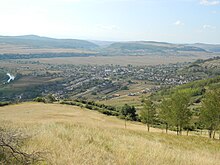Micasasa
|
Micasasa fig village Mikeszásza |
||||
|
||||
| Basic data | ||||
|---|---|---|---|---|
| State : |
|
|||
| Historical region : | Transylvania | |||
| Circle : | Sibiu | |||
| Coordinates : | 46 ° 5 ' N , 24 ° 6' E | |||
| Time zone : | EET ( UTC +2) | |||
| Height : | 284 m | |||
| Area : | 71.38 km² | |||
| Residents : | 2,058 (October 20, 2011) | |||
| Population density : | 29 inhabitants per km² | |||
| Postal code : | 557145 | |||
| Telephone code : | (+40) 02 69 | |||
| License plate : | SB | |||
| Structure and administration (as of 2016) | ||||
| Community type : | local community | |||
| Structure : | Micăsasa, Chesler , Țapu , Văleni | |||
| Mayor : | Sorin-Vasile Popa ( PSD ) | |||
| Postal address : | Str. 1 Decembrie 1918, no. 144 loc. Micasasa, jud. Sibiu, RO-557145 |
|||
| Website : | ||||
Micasasa (obsolete Micsasa , Micasasa ; German Feige village , Hungarian Mikeszásza ) is a municipality in Sibiu county in the region of Transylvania in Romania .
The place is also known by the German names Fägendorf and Fegendorf .
Geographical location
The municipality of Micăsasa is located in the Transylvanian Basin , in the Kokel Valley , on the lower reaches of the Târnava Mare ( Great Kokel ). On the Teiuş – Braşov railway line and the national road ( drum național ) DN 14B, the place is 16 kilometers west of the small town of Copşa Mică ( Kleinkopisch ); the district capital Sibiu (Hermannstadt) is about 60 kilometers south.
history
The place Micăsasa was first mentioned in 1215. On the former crown land was Fägendorf a Nationals village. Samuel von Brukenthal , governor of Transylvania, had a winery here. The last Protestant pastor of Feigendorf left the parish in 1796 due to insufficient membership and moved to Langenthal ( Valea Lungă ), seven kilometers away .
According to JM Ackner , JF Neigebauer u. a. is located in the village, between the train station and the church, an archaeological site that indicates a settlement in Roman times . Furthermore, finds that point to the Bronze Age were made.
At the time of the Austro-Hungarian monarchy , the place belonged to the Hosszúaszó chair district of the Klein-Kokelburger county .
population
The population of the municipality developed as follows:
| census | Ethnic composition | |||||||
|---|---|---|---|---|---|---|---|---|
| year | population | Romanians | Hungary | German | other | |||
| 1850 | 2,868 | 2,051 | 206 | 309 | 302 | |||
| 1941 | 3,915 | 3,061 | 135 | 509 | 210 | |||
| 1977 | 3,589 | 2,940 | 213 | 360 | 76 | |||
| 1992 | 2,559 | 2.234 | 150 | 133 | 42 | |||
| 2002 | 2,426 | 2,231 | 134 | 23 | 38 | |||
| 2011 | 2,058 | 1,845 | 94 | 12 | 107 (31 Roma) | |||
Since 1850 the highest number of inhabitants and at the same time that of the Romanian Germans in 1941 was determined in the area of today's municipality. The highest number of Romanians (3327) was counted in 1956, that of Roma (232) in 1850 and that of Magyars (309) in 1890. Furthermore, one Serb was registered in 1960, five in 1910, three in 1930 and a Slovak in 1956 . Most of the Romanian Germans were registered in the incorporated village of Țapu ( Abtsdorf ); from 1850 to 1941 there were about 100 fewer than Romanians.
Attractions
- The former Protestant church, built in the 13th century, renovated in the 15th and rebuilt in the 18th century, today known as the Reformed and Roman Catholic Church of the Trinity , is a listed building. The Roman Catholic believers use the choir, the Reformed the hall of the church.
- The Brukenthal property built in the 18th century is a listed building.
- In the incorporated village of Țapu the evangelical fortified church, built in the 14th century, is a listed building.
Personalities
- István Asztalos (1906–1960), Hungarian writer
Web links
Individual evidence
- ↑ 2011 census in Romania ( MS Excel ; 1.3 MB)
- ^ Dictionary of the localities in Transylvania
- ↑ a b c Heinz Heltmann, Gustav Servatius (ed.): Travel Guide Siebenbürgen. Kraft, Würzburg 1993, ISBN 3-8083-2019-2 .
- ^ Institute Of Archeology - Micăsasa , accessed June 22, 2015 (Romanian).
- ↑ Census, last updated November 4, 2008 (Hungarian; PDF; 1.1 MB)
- ↑ a b c List of historical monuments of the Romanian Ministry of Culture, updated 2010 (Romanian; PDF; 7.10 MB)
- ↑ Information on István Asztalos from oszk.hu accessed on June 19, 2015 (Hungarian)





